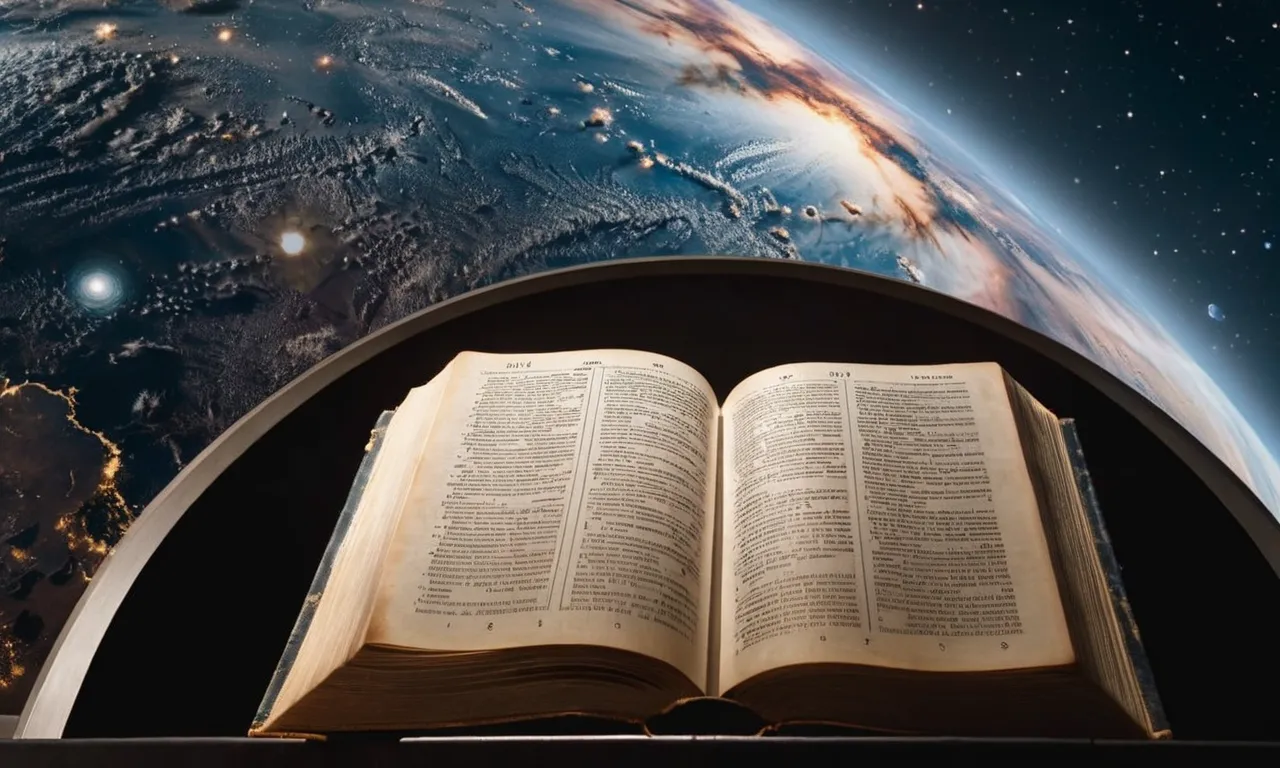How Many Planets Are Mentioned In The Bible?
The night sky has captivated humanity since the beginning of time. Ancient people groups like the Babylonians carefully tracked the stars and planets overhead, ascribing gods and myths to the celestial bodies they saw.
The authors of the Bible lived under similar starry skies, and while the Bible doesn’t focus on astronomy, a few key passages give insight into ancient cosmology and the planets visible to the naked eye.
If you’re short on time, here’s a quick answer to your question: Only five planets are explicitly mentioned in the Bible – Mercury, Venus, Mars, Jupiter and Saturn. These planets were visible to ancient observers and played a role in their mythologies.
The Ancients’ View of the Cosmos
Ancient Near East Cosmology
Ancient civilizations like the Babylonians, Egyptians, and Hebrews had a very different understanding of the cosmos than we do today. They viewed the world as a flat disk or rectangle floating on the primordial waters. The sky was a solid dome that rested on the earth.
Celestial bodies like the sun, moon, planets and stars moved across the underside of this dome. There was an ocean above the dome and waters below the earth.
This ancient cosmology conceived of a tiered universe with three levels – the heavens above, the earth in the middle, and the underworld below. The heavens were the realm of the gods, the underworld was the land of the dead, and the earth was the realm of humans.
The ancients believed that events on earth were controlled by the gods above. Natural phenomena like eclipses, storms, flooding were seen as signs of divine activity.
Astronomical objects were closely associated with gods and spirits. For example, the Babylonians considered planets to be living gods that exerted influence over human lives. The Egyptians saw the movement of celestial bodies as the actions of deities traveling across the sky.
Ancient cosmologies were centred on supernatural and mythological explanations rather than scientific observation.
Planets Visible to the Naked Eye
The naked eye can see five planets in our solar system – Mercury, Venus, Mars, Jupiter, and Saturn. These planets have been known since ancient times as they are bright enough to be seen without a telescope. The Greeks and Romans named them after their gods.
The ancient astronomers could track the predictable movements of these wanderers across the celestial sphere. They noticed that the planets moved independently against the background of fixed stars. The planets even seemed to occasionally move backwards in retrograde motion before resuming their usual course.
The ancient Greeks developed geometrical models to explain retrograde motion. In the 2nd century AD, Ptolemy’s geocentric model proposed that planets orbited in small circles called epicycles around larger circles that revolved around the Earth.
This explained their unusual looping paths across the sky.
However, naked eye observations were limited. Features like cloud bands on Jupiter, rings of Saturn, phases of Venus and mercury were not visible. The true nature of planets was not uncovered until the invention of telescopes and progress in understanding gravity in the 1600s.
Mercury
Mercury is the smallest planet in our solar system and the closest to the Sun. It is only mentioned a few times in the Bible:
- Job 38:7 – When the morning stars sang together, and all the sons of God shouted for joy?
- Psalm 104:19 – He appointed the moon for seasons: the sun knoweth his going down.
- Amos 5:8 – Seek him that maketh the seven stars and Orion, and turneth the shadow of death into the morning, and maketh the day dark with night: that calleth for the waters of the sea, and poureth them out upon the face of the earth: The LORD is his name:
These verses make poetic references to the “morning star” or “stars” which could include Mercury. However, Mercury is not directly named in the Bible.
As the innermost planet to the Sun, Mercury has a rapid orbit which takes only 88 days to complete. This speedy movement of Mercury across the sky led ancient astronomers to name it after the Roman deity Mercury, who was the messenger to the gods. The Greeks called it Hermes for the same reason.
Some key facts about Mercury:
- Mercury has no moons or rings.
- It is the smallest planet, only slightly larger than Earth’s moon.
- Mercury is the second densest planet after Earth.
- It has a very thin atmosphere of oxygen, sodium, hydrogen, helium and potassium.
- Mercury has a large iron core making up about 70% of its mass.
- The surface is covered with craters like our moon due to meteorite impacts.
- Temperatures range from 800°F on the day side and -280°F on the night side.
Despite being close to the Sun, Mercury is not the hottest planet in our solar system. That title goes to Venus whose thick atmosphere traps heat. However, being sun-facing all the time does make Mercury’s day side extremely hot.
Without an atmosphere to distribute heat, the night side of Mercury gets extremely cold in the darkness.
Mercury does not play a significant role in the Bible, but its speedy movements across the dawn and evening sky were well known to ancient people. They appreciated the majesty of creation in poetic verses and recognized the hand of God in making the heavens and all the stellar bodies.
Venus
Venus is not directly mentioned by name in the Bible. However, some scholars believe that references to “the morning star” or “Lucifer” may refer to the planet Venus.
“Morning Star” References
In Isaiah 14:12, the king of Babylon is compared to the “morning star” (or “son of the dawn”) which has “fallen from heaven.” This could be interpreted as referring to the planet Venus, which is often the brightest star/planet visible in the morning sky:
“How you have fallen from heaven, morning star, son of the dawn! You have been cast down to the earth, you who once laid low the nations!”
However, most biblical scholars believe this passage is using metaphorical language to refer to the king’s glory and splendor being taken away, rather than literally referring to a star or planet.
The term “morning star” is also used in 2 Peter 1:19 and Revelation 2:28 and 22:16. In these passages it seems to be used as a symbolic title for Jesus rather than literally referring to the planet Venus:
“I, Jesus, have sent my angel to give you this testimony for the churches. I am the Root and the Offspring of David, and the bright Morning Star.” (Revelation 22:16)
Lucifer References
The Latin word “Lucifer” means “light-bearer” and is the term used in most Latin translations of the Bible for the “morning star” passage in Isaiah 14. This led to Lucifer becoming another title associated with the devil in Christian tradition.
However, it is debatable whether the original Hebrew text was truly equating Satan with Venus or simply using flowery metaphorical language.
So while Venus has been linked to certain biblical passages by later commentary and interpretation, it does not seem to be explicitly mentioned as a planet in the literal text of the Bible.
Mars
Mars is the fourth planet from the Sun and the second smallest planet in the Solar System after Mercury. Named after the Roman god of war, Mars is a rocky planet with a thin atmosphere and has polar ice caps of frozen water and carbon dioxide.
The existence of water on Mars is of great interest to scientists because it increases the chance that life may have once existed on Mars, or could exist there today.
Mars is mentioned a few times in the Bible, both directly and indirectly. Here are some of the key biblical references to Mars:
- In Job 25:5, Elihu asks Job “Behold even the moon, and it shineth not; yea, the stars are not pure in his sight.” The Hebrew word translated here as “stars” can refer to planets like Mars.
- Acts 7:43 quotes the prophet Amos referring to “the star of your god Rephan”. This may be a reference to the planet Mars which represented the Mesopotamian god Nergal.
- The description of judgment in Revelation 8:10 talks about a “great star” called Wormwood falling from heaven. Some commentators have speculated this could refer to an asteroid or comet originating from the orbit of Mars.
While Mars is not directly mentioned by name, these verses show the biblical authors were aware of its existence as one of the wanderers in the night sky. The red color of Mars may have given rise to its association with blood, war, and judgment in ancient Near Eastern cultures.
However, the Bible does not ascribe any astrological significance to the planets. Instead, the heavens declare the glory of God (Psalm 19:1).
Key Facts about Mars
Here are some key facts about the planet Mars:
- Mars is the 2nd smallest planet in our solar system after Mercury.
- The average distance of Mars from the Sun is 141 million miles.
- Mars takes 687 Earth days to orbit the Sun.
- A day on Mars is called a sol and lasts 24 hours and 37 minutes.
- Mars has two moons – Phobos and Deimos.
- The atmosphere on Mars is thin and composed mainly of carbon dioxide.
- Mars has seasons, polar ice caps, volcanoes, canyons, and weather.
- The temperature on Mars ranges from -225°F to 70°F.
- Mars is known as the “Red Planet” due to the high iron content in its soil.
- No human has ever set foot on Mars, but NASA plans to send astronauts in the 2030s.
Studying and exploring Mars provides insights into the history of our solar system. It also allows us to test technologies for future human exploration of space. While Mars has long captured our imagination in science fiction, the real story of the Red Planet continues to unfold as we send advanced rovers and orbiters to map and investigate its mysteries.
Jupiter
Jupiter is the largest planet in our solar system and has been known since ancient times. It is mentioned numerous times in the Bible, both directly by name and indirectly through allegory and metaphor. Here is an overview of the biblical references to this gas giant planet:
Direct Mentions of Jupiter
The name Jupiter comes from the Roman god of the same name. In the Old Testament, written originally in Hebrew, the planet is called Tzedek or Tzedeq, which means “righteousness”. It is mentioned in the following verses:
- Isaiah 48:13 – “Surely My hand founded the earth, And My right hand spread out the heavens; When I call to them, they stand together.” Here God is speaking of creating the heavens and earth, including Jupiter.
- Amos 5:8 – “He who made the Pleiades and Orion And changes deep darkness into morning, Who also darkens day into night, Who calls for the waters of the sea And pours them out on the surface of the earth, The LORD is His name.” Again a reference to God’s creation, including Jupiter.
In the New Testament, written in Greek, Jupiter is referred to by its Greek name Zeus or sometimes simply as aster, the Greek word for star.
- Acts 7:43 – “You also took along the tabernacle of Moloch and the star of the god Rompha, the images which you made to worship. I also will remove you beyond Babylon.” Moloch was a pagan Mesopotamian god and Rompha has been linked by some scholars to the Greek Zeus/Jupiter.
- Acts 19:35 – “After quieting the crowd, the town clerk said, ‘Men of Ephesus, what man is there after all who does not know that the city of the Ephesians is guardian of the temple of the great Artemis and of the image which fell down from heaven?'”
The image that fell from heaven refers to a meteorite that was worshipped as Zeus/Jupiter.
Metaphorical Mentions
In addition to direct references, Jupiter is mentioned metaphorically in several verses that refer to its brilliance in the night sky.
- Job 25:5 – “If even the moon has no brightness And the stars are not pure in His sight.” The verse contrasts God’s glory to even the brightness of the moon and stars, including Jupiter.
- Ezekiel 32:7 – “‘And when I extinguish you, I will cover the heavens and darken their stars; I will cover the sun with a cloud And the moon will not give its light.” An eclipse is used as a metaphor for disaster befalling Egypt.
- Joel 2:10 – “Before them the earth quakes, The heavens tremble, The sun and the moon grow dark And the stars lose their brightness.” Dramatic celestial events are used to describe God’s judgment.
- Joel 3:15 – “The sun and moon grow dark And the stars lose their brightness.” Another passage likening spiritual darkness to the darkening of Jupiter and other celestial bodies.
Saturn
Saturn is the sixth planet from the Sun and the second largest planet in our solar system. With its famous rings, Saturn is one of the most fascinating and recognizable planets. Though Saturn was known to ancient astronomers, the invention of the telescope allowed us to fully observe its rings and moons starting in the 1600s.
Since then, visiting spacecraft have revealed many surprises and mysteries about this giant, gaseous world.
Some key facts about Saturn:
- Saturn has a radius of 36,184 miles (58,232 km), over 9 times wider than Earth. If Earth was the size of a nickel, Saturn would be about as big as a volleyball.
- Saturn takes 29.4 Earth years to orbit the Sun. A day on Saturn is just 10.7 hours long.
- Saturn is a gas giant, composed primarily of hydrogen and helium. Its atmosphere is cloudy and stormy, with winds over 1,100 mph (1,800 km/h).
- Saturn has 62 known moons, with Titan being the largest. Titan has lakes of liquid methane and a thick nitrogen atmosphere.
- Saturn’s rings are 175,000 miles (280,000 km) across but only around 30 feet (10 m) thick. The main rings are made of countless small particles of ice and rock.
Saturn is the furthest planet from Earth that is easily visible to the naked eye. It has been known since prehistoric times and was the most distant of the five planets known to ancient astronomers. In 1610, Galileo Galilei was the first to observe Saturn’s rings, though he mistook them for two larger moons on either side.
In 1659, Christiaan Huygens correctly deduced the rings were a solid disk surrounding Saturn. The discovery of Saturn’s moons began in the 1600s by astronomers like Giovanni Cassini.
By the late 1800s, astronomers speculated there were openings or gaps in Saturn’s rings. This was confirmed when the twin Voyager spacecraft flew by in 1980 and 1981. The gaps are caused by the gravity of moons orbiting within the rings.
Voyager also discovered several new moons and that Saturn’s rings are made of countless smaller ringlets. The Cassini spacecraft orbited Saturn from 2004 to 2017, observing storms, taking detailed images of the rings and moons, and even discovering liquid lakes on Titan.
There are several references to Saturn in the Bible. In ancient times, Saturn was sometimes associated with the Sabbath day of rest. The Hebrew word for Saturn is ‘Shabbtai’, similar to Sabbath. Amos 5:26 mentions ‘the star of your god Rephan’, which some scholars think refers to Saturn.
Acts 7:43 also mentions the ‘star of Rephan’. So while Saturn itself is not directly mentioned, these verses may refer to its idolization in ancient pagan religions.
Conclusion
The night sky was full of mystery and meaning for ancient observers. While the Bible focuses on theological matters rather than astronomical ones, it still provides some insights into how ancient Israelites viewed the five bright wanderers overhead.
The planets Mercury, Venus, Mars, Jupiter and Saturn each make appearances in Scripture, giving modern readers a glimpse into the ancient cosmos.







